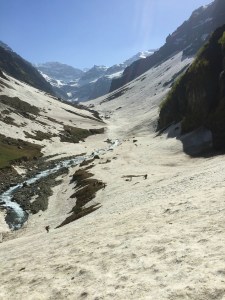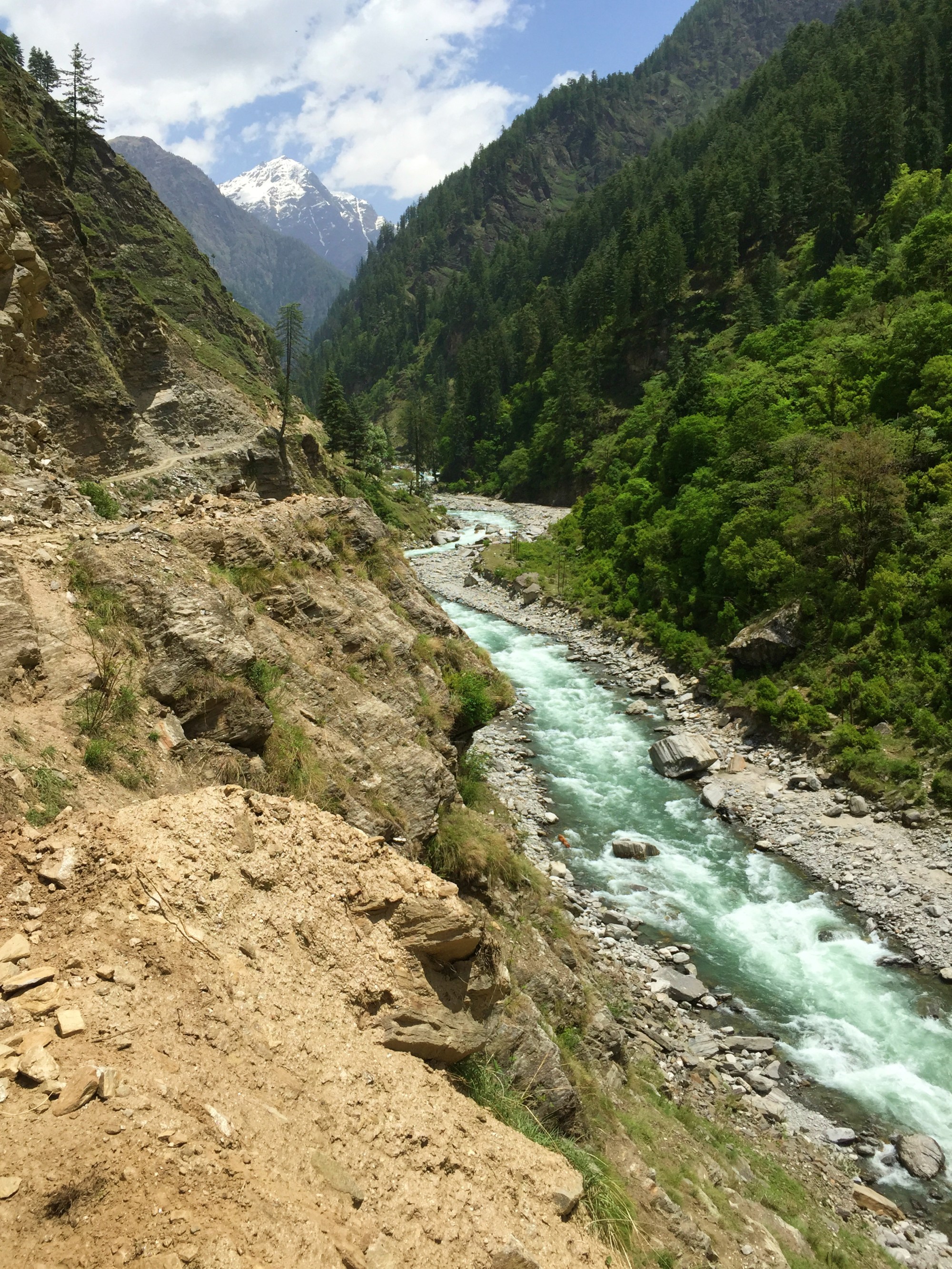The best way to experience the Himalayas
No it’s not by going to Manali. Not that I have anything against Manali, but it’s beyond touristy now. It’s a great starting point for for experiencing the real himalayas though. Yes Rohtang does come close. For those who have never seen much snow, it well worth it waiting 2 hours in a cramped Tata Sumo to see the fresh ice. Anyway, I am talking about experiencing the himalayas by going on a trek–backpacks and tents included. The allure of a trek is that you get to spend time in the wilderness, away from the bustle of cities and city people.
Living in Singapore is great but the weather can really get to you. It is hot and humid all year around. To make things worse, there is barely any wind. The real feel is always > 36 degrees. So when we decided to go on a trek, it had to be in a cold place. The alps were out of the question due to time and expenses. So I started searching around for cold places to trek in. It had to have:
- forests
- snow
- rivers
- valleys
- mountains
It took me about 5 minutes of brainstorming to realise that i could experience all of the above in my own backyard – The Himalayas. Next: which part of the Himalayas to go to? For the uninitiated, the Himalayas are the tallest and the most intimidating mountain ranges in the world. They span across from Afghanistan all the way to China and East India and include some 12 countries along the way. They are the source of fresh water to 500 million Indians. The high himalayan glaciers give rise to the massive Ganges, Brahmaputra and Indus rivers. So then again, where do we go?
Nepal? Sikkim? Arunachal? Himachal? Ladakh? Uttaranchal? Kashmir? Gilgit-Baltistan? Tibet?
I turned to google images. Well, all these places seemed quite breathtaking. I needed a better approach to decide. But first, I settled on trekking in the Indian Himalayas. For starters, it’s my homeland and that would make navigation and communication pretty easy. This meant that I had to narrow down to one region among Sikkim, West Bengal, Himachal, Uttaranchal and Kashmir. To help me decide, I turned to the old faithful – r/India. Took me about 10 mins of perusing the trekking threads to come across Indiahikes. These guys are a trekking startup based in Bengaluru. They organize trekking tours across India. Their website even listed treks based on whether you wanted to experience snow and which months give you the best experience. They had treks to Himachal, Uttaranchal and Sikkim. They listed treks based on difficulty level. Man each trek had a baseline fitness level you had to have!

Then I looked at the different treks mentioned and settled upon Rupin Pass. It’s a trek that starts in Uttaranchal and ends in Sangla, Himachal Pradesh. An 8 day trek with days 4-8 in high snow…and this is in the month of May when the snow cover is the highest. Being at a high altitude, the Himalayan villages are spared the wrath of the Indian summer. Temperatures of 2 degress in India in May felt like a great deal. Sitting in Singapore in 30 degree weather, I knew I had to do this Rupin Pass trek.
And so we paid the fee of INR 14000 for the 8 day Rupin Pass trek in May 2015. Next, getting fit enough to do the trek and buying trekking equipment….

According to Indiahikes, you need to be able to complete a 5km run in 30mins to consider yourself fit enough to do the trek. They also detail a fitness plan you can follow for 8 weeks to get match fit. I followed that and was able to complete 5km in 34mins after a month. Since I was already working out every week, getting match fit wasn’t too hard. If you’ve never exercised and are attempting a trek, start training about 4-5 months before it. You’ll thank me when you’re suspended above a valley with a 60 degree slope and you gotta rely on your thigh muscles to stand still.
Another note: I got an intense bout of flu/cough/cold about a month before the trek and that completely fucked my training up. Nevertheless, I recovered with tons of fluids, meds and sleep. So just keep an eye out for Murphy’s law. Take enough medicines along with you. Check out the Indiahikes guide on what to pack before a Himalayan trek. Ladies make sure you plan your trek so it doesn’t happen during your cycles. You don’t want to be feeling ‘icky’ at 12000 feet trust me.
DAY 1
On to the travel bit. Booked my flights on Air India from Singapore-Delhi. AI has the new dreamliner jet. The journey was pleasant surprise. After hearing so many horror stories about Air India, this one was smooth and punctual. Landed in delhi, met my relatives and headed straight to the New Delhi Railway Station (NDLS) to take the Jan Shatabdi to Dehradun. Usual train journey, little delayed but reached around midnight. Had a stayover in some dingy hotel close to the station. Next morning, went back to the station to meet up with the trekkers and the Indiahikes driver who would take us on a 8hr journey to our basecamp in Dhaula.
We left Dehradun at 7am in a Tata Sumo with 6 other trekkers. Uneventful 8hrs with a couple of pit stops for food and drink. We arrived at the basecamp at about 6pm. The Indiahikes team had already setup some 10-12 tents for us and there were 2 admin tents and a kitchen. There were 4 makeshift toilets at the far end of the camp. The atmosphere was awesome. The camp was located in a large clearing surrounded by hills, tall trees and a loud blue river gushing alongside it. The weather was cool and the skies were clear. Game on!
We had some food and chai prepared by the talented Indiahikes chefs. After that there was a group briefing with our Trek Leader Hemang. 17 of us introduced each other and we were debriefed on the do’s and dont’s (no smoking, having the proper gear, no being an asshole etc).
It was an early start to Day 2 so we were all off to bed. Aside from a group of mules shitting on our tent in the night, it was smooth sailing. One of the super mules almost fell on the tent. This happened because the sacks of corn were super close to our tent area. Do note that the mules carried the cooking equipment and luggage all the way to our Day 8 destination.
According to Indiahikes, you need to be able to complete a 5km run in 30mins to consider yourself fit enough to do the trek. They also detail a fitness plan you can follow for 8 weeks to get match fit. I followed that and was able to complete 5km in 34mins after a month. Since I was already working out every week, getting match fit wasn’t too hard. If you’ve never exercised and are attempting a trek, start training about 4-5 months before it. You’ll thank me when you’re suspended above a valley with a 60 degree slope and you gotta rely on your thigh muscles to stand still.
Another note: I got an intense bout of flu/cough/cold about a month before the trek and that completely fucked my training up. Nevertheless, I recovered with tons of fluids, meds and sleep. So just keep an eye out for Murphy’s law. Take enough medicines along with you. Check out the Indiahikes guide on what to pack before a Himalayan trek. Ladies make sure you plan your trek so it doesn’t happen during your cycles. You don’t want to be feeling ‘icky’ at 12000 feet trust me (or a certain lady in our trek group whose peak period hit just as we were in the toughest part of the trek).
On to the travel bit. Booked my flights on Air India from Singapore-Delhi. AI has the new dreamliner jet. The journey was pleasant surprise. After hearing so many horror stories about Air India, this one was smooth and punctual. Landed in delhi, met my relatives and headed straight to the New Delhi Railway Station (NDLS) to take the Jan Shatabdi to Dehradun. Usual train journey, little delayed but reached around midnight. Had a stayover in some dingy hotel close to the station. Next morning, went back to the station to meet up with the trekkers and the Indiahikes driver who would take us on a 8hr journey to our basecamp in Dhaula.
We left Dehradun at 7am in a Tata Sumo with 6 other trekkers. Uneventful 8hrs with a couple of pit stops for food and drink. We arrived at the basecamp at about 6pm. The indiahikes team had already setup some 10-12 tents for us and there were 2 admin tents and a kitchen. There were 4 makeshift toilets at the far end of the camp. The atmosphere was awesome. The camp was located in a large clearing surrounded by hills, tall trees and a loud blue river gushing alongside it. The weather was cool, the skies were clear and game on!
[I need to finish this article]
comments powered by Disqus